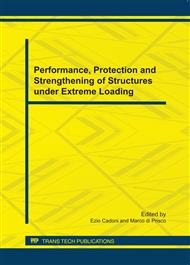[1]
US General Services Administration: GSA-TS01-2003: Standard Test Method for Glazing and Window Systems, Subject to Dynamic Overpressure Loadings, 2003.
Google Scholar
[2]
International Organization for Standardization: ISO 16933:2007: Glass in building – Explosion-resistant security glazing – Test and classification for arena air-blast loading, 2007.
Google Scholar
[3]
Joint Research Centre (JRC), Commissariat à l'Énergie Atomique (CEA), http://europlexus.jrc.ec.europa.eu/, EUROPLEXUS User's manual, 2010.
Google Scholar
[4]
C. Kranzer. G. Gürke, C.: Mayrhofer. Testing of Bomb Resistant Glazing Systems Experimental Investigation of the Time Dependent Deflection of Blast Loaded 7.5 mm Laminated Glass. Glass Processing Days 2005.
Google Scholar
[5]
M. Larcher, F. Casadei: Explosions in complex geometries - a comparison of several approaches. International Journal of Protective Structures, vol. 1, no. 2, p.169–195, 2010.
DOI: 10.1260/2041-4196.1.2.169
Google Scholar
[6]
M. Wagner, R. Müller: Berechnung sprengwirkungshemmender Fenster- und Fassadenkonstruktionen, 5. LS-DYNA Anwenderforum, 2006.
Google Scholar
[7]
M. Timmel, S. Kolling, P.Osterrieder, P. Du Bois: A finite element model for impact simulation with laminated glass, International Journal of Impact Engineering Vol. 34, 2007, p.1465–1478.
DOI: 10.1016/j.ijimpeng.2006.07.008
Google Scholar
[8]
C. Morison, M. Zobec, A. Frenceschet: The measurement of PVB properties at high strain rates, and their application in the design of laminated glass under bomb blast. ISIEMS 2007, International Symposium on Interaction of the Effects of Munitions with Structures, 17-21 September, Orlando, US, 2007.
Google Scholar
[9]
R. Iwasaki, C. Sato, J.L. Latailladeand, P. Viot: Experimental study on the interface fracture toughness of PVB (polyvinyl butyral)/glass at high strain rates. International Journal of Crashworthiness Vol.12 (3) (2007), p.293–298.
DOI: 10.1080/13588260701442249
Google Scholar
[10]
S. Bennison, J. Sloan, D. Kistunas, P. Buehler, T. Amos, C. Smith: Laminated glass for blast mitigation: Role of interlayer properties. Glass Processing Days, 2005.
Google Scholar
[11]
Kingery, Charles N.; Bulmash, Gerald: Airblast Parameters from TNT Spherical Air Burst and Hemispherical Surface Burst, Defence Technical Information Center, Ballistic Research Laboratory, Aberdeen Proving Ground, Maryland, 1984.
Google Scholar
[12]
M. Larcher, N. Gebbeken, M. Teich, G. Solomos: Simulation of laminated glass loaded by air blast waves. International Symposium on the Application of Architectural Glass, Munich, Germany, October 4-5 2010.
DOI: 10.4028/www.scientific.net/amm.82.69
Google Scholar


